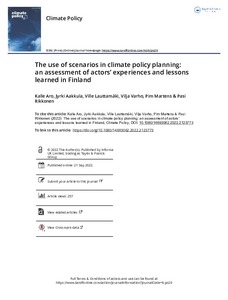The use of scenarios in climate policy planning: an assessment of actors’ experiences and lessons learned in Finland
Aro Kalle; Aakkula Jyrki; Lauttamäki Ville; Varho Vilja; Martens Pim; Rikkonen Pasi
https://urn.fi/URN:NBN:fi-fe2022112967942
Tiivistelmä
Scenarios are often used to depict the possible outcomes of alternative future developments as part of the evaluation of climate and energy policy measures. In Finland, scenarios have become a standard practice in climate-related policy planning. However, scenario planning often results in a single cohesive narrative, which lacks transparency in why certain developments and solutions are included and others left out. This article focuses on how scenarios created during the planning of Finland’s Medium-term Plan for Climate Change Policy (KAISU) were built, and how the actors involved assessed the characteristics and quality of these scenarios. We interviewed a total of 18 participants from research, administration, and policymaking domains involved in the creation of the plan and the scenarios it contains. Semi-structured interviews provided an insight into the creation and use of scenarios as part of policy formulation, as well as points of further improvement for the process. The KAISU plan was constructed as a cross-sectoral collaborative effort between policymakers, public officials, and researchers. Despite the variety of actors involved in the process, the resulting scenarios were perceived as well-executed by the participants. However, national scenario foresight could be improved in three dimensions: 1) the process where actors collaborate to build scenarios, 2) the scenario methodology, where solutions and developments are included or excluded, and 3) use of the scenarios after their construction.
Kokoelmat
- Rinnakkaistallenteet [27094]
